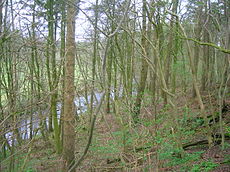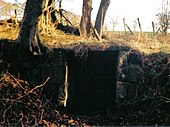Lambroughton
Timothy Pont's map of 'Cuninghamia', surveyed in the early 17th century (1604–1608), but not published until the 1654 atlas by Joan Blaeu indicates the place names of 'Lambrochmill', 'Mains of Lambrochton' and 'Lambrochton B.(bridge?)'.
[7] The Barony of Kilmaurs was composed of the lands of Buston, also Bowieston and Buythstoun (now Buiston), Fleuris (now Floors), Lambroughton, Whyrrig, (now Wheatrig) and previously Quhytrige,[8] and Southwick or Southuck (now South Hook).
King Alexander II (1198–1249) gave the whole barony of Kilmaurs to Henry de Conyghame and then it is recorded that all the lands of Cunyngham were granted to a Robert Stuart, son of Walter (before 1321).
He was an advocate, one of the most distinguished lawyers of his day,[16]: 649 and obtained the sanction of parliament to use vacant stipends for the purpose of repairing churches and manses in these parishes.
The parents of local character, businessman, steam, tractor and agricultural implements enthusiast Frank 'Rob Roy' Neill lived here for a short while after they were married, moving to Kilmaurs after about a year.
[28] As stated this farm is shown in the Montgomerie Estates plans by John Ainslie in 1789 as having existed on the other side of the toll road from West Lambroughton.
[33] One 'ghost story' relates that when a well-liked and respected octogenarian farmer from West Lambroughton died in the 1990s, at around midnight on the night before the funeral the sound of dancing in hobnail boots could be heard coming from the crossroads with a tawny owl screeching its presence from a nearby telegraph pole for the first and only known time.
Robertson records that the widow of Mr. James Ross of Whiteriggs (Wheatrig), Christian Wallace daughter to the Laird of Auchans, married William Rankine of Shiel and thereafter became Lady Dreghorn.
[48] A mill-wand was the rounded piece of wood acting as an axle with which several people would role a millstone form the quarry to the mill and to permit this the width of some early roads was set at a 'mill-wand breadth'.
The Stewarton flower, named for its local abundance by the Kilmarnock Glenfield Ramblers, is otherwise known as pink purslane (Claytonia sibirica) is found in damp areas.
Some confusion exists in the surviving records, for either an Archibald or a James Mure, Burgess of Glasgow, married Margaret, daughter of Robert Ross of Thorntoun on 27 June 1607.
This situation, known as the feudal Barony right of 'pit and gallows' existed at many other sites, such as at Kilmarnock, Aiket, Ardrossan, Dalry, Largs, Carnell, Giffen and Mugdock where the castle, mound and lochan have this scenario attached to their history.
[36] Hunter or Tod Gibbie was a character in Sir Walter Scott's Guy Mannering, based on Gabriel Young who lived in Kilmaurs.
Gabriel had a pack of twelve slow-hounds to give tongue, six greyhounds to catch by speed and eight terriers to deliver the coup de grâce.
[9] At the age of 11 this young girl, daughter of the Laird of Bargarran, in the parish of Erskine, took a violent dislike to one Catherine Campbell, a domestic servant.
Christian decided to achieve the death of Catherine by feigning possession by evil spirits, so she threw fits with violent contortions of her body and ejected egg-shells, fur balls, chicken bones, etc.
So convincing was she, that she achieved a great deal of attention, and this encouraged her in the end to accuse twenty-four men and women, old and young, of taking an oath to follow Satan.
This was one of the most cunning and diabolical episodes in the annals of witchcraft, however Christian was never held to account and went on to marry Mr. Millar, the minister of Kilmaurs from 1718 - 21[61][62] and after his death actually set the foundations for the thread manufacturing trade of Paisley.
[15][64] James, the fourteenth Earl of Glencairn broke the centuries-old connection of the Cunnighame family with the area by selling the estate of Kilmaurs in 1786 to the Marchioness of Titchfield.
The property stayed in the Robertland family and their descendants until 1841, when Robert Parker Adam purchased the lands and rebuilt the Mansion House in the old English style.
He is said to have been killed here in 1444 after leading a band of English mercenaries into the Kilmarnock area and then subsequently suffering a rout at the hands of the Boyd's of Dean Castle.
He could only be bound by a three-stranded rope of sand, but they got over the problem of hanging him by binding him in a lead sheet and boiling himn to death for the murder of the Laird of Branxholm.
In Bede's Ecclesiastical History of the English Church and People written in AD 731 is recorded the case of a Cunningham of Northumbria who died after a gradually worsening illness.
[73] Standalane—a number of properties in this area have this name, however no obvious pattern exists, other than its humorous use in connection with lonely or solitary places[41] or a dwelling just outside a village or town.
Feuds were a feature of life in old Ayrshire and in 1547 Sir Neil Montgomerie of Lainshaw was killed by Lord Boyd of Kilmarnock in a skirmish which took place in the streets of Irvine (Robertson 1908).
The old sandstone parapet of the bridge overlooking the site of Cunninghamhead railway station has many carvings on it, probably made over the years by local children and pupils from the primary school as they waited and watched the old steam and diesel trains going by on this long closed line.
A ball of fine-grained sandstone, 2+1⁄2in (63mm) in diameter, with the surface ornamented by six equal, circular and slightly projecting discs, found at Jock's Thorn Farm (NS 417 410).
The Tour streamlet joins the Carmel nearby and before the confluence can be found an old well, arched over, known as the Lady's well, with never-failing, excellent and refreshingly cool water.
[9] Lord John Boyd Orr, awarded the Nobel Peace Prize was born in Holland Green on the Fenwick Road in Kilmaurs.
[46] The Royal Mail re-organised its postal districts in the 1930s and at that point many hamlets and localities ceased to exist officially, such as Templehouse, Darlington, Goosehill and other areas in Stewarton.

















































